The Volokh Conspiracy
Mostly law professors | Sometimes contrarian | Often libertarian | Always independent
Constitutional Places: The FDR Presidential Library
The library offered some balance with respect to Court Packing and Japanese Internment.
On Saturday, I visited the FDR Presidential Library in Hyde Park, New York. I had previously visited seven other presidential libraries. Bush 43, Clinton, Bush 41, Reagan, Carter, Ford, and Johnson. (I wrote about my visit to the Clinton library here).
The FDR library was very impressive. Roosevelt confronted so much in four terms. The Great Depression. The New Deal. World War II. And so on. It was difficult to condense everything in a few exhibits. By contrast, the Carter and Bush 41 libraries felt like they were working hard to fill large spaces. The one-termers just don't have as much to show.
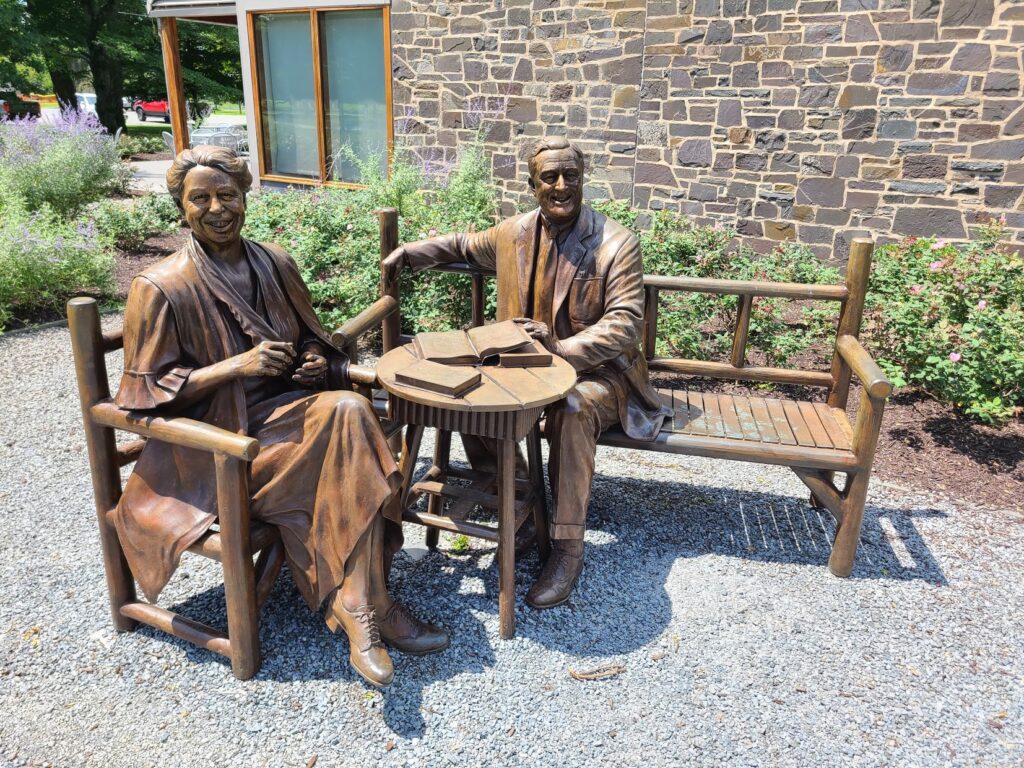
In this post, I will highlight how the museum handled topics related to Supreme Court during FDR's tenure.
First, there was the gavel used to announce FDR's nomination in 1932. If you squint, Robert Jackson signed the plaque as Secretary.
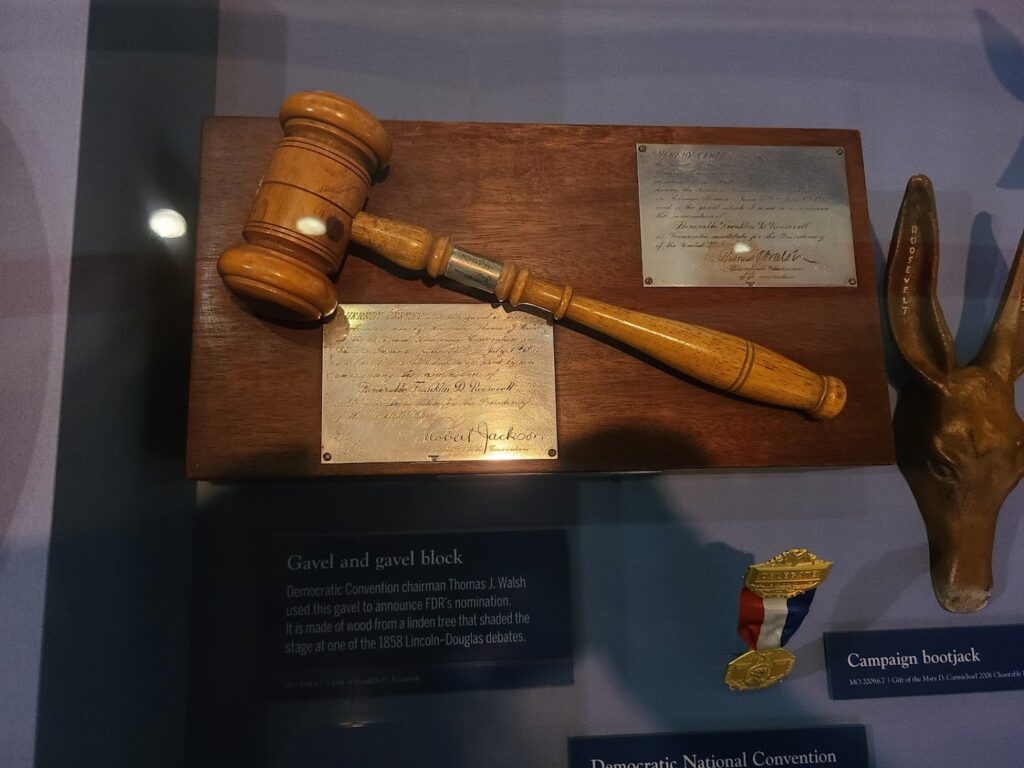
Second, here is a photograph of Chief Justice Hughes issuing the oath of office:

Third, there was an exhibit on FDR's first 100 days. The descriptions were refreshingly balanced:
Some of FDR's initiative succeeded. Others failed. Some programs were contradictory.
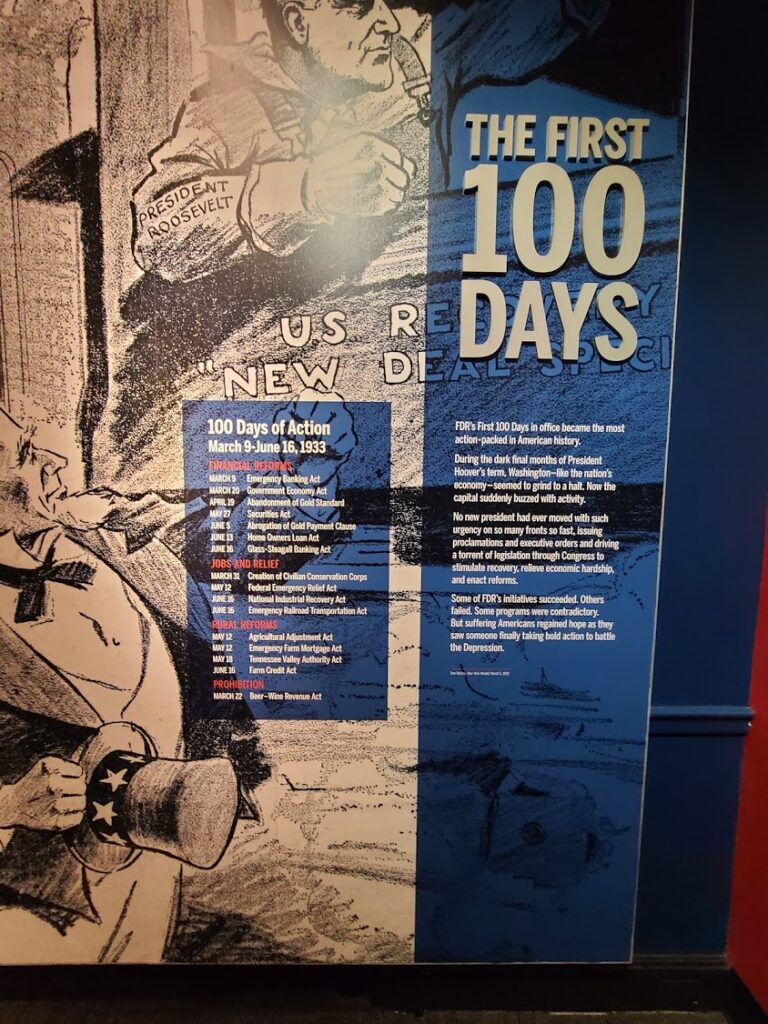
Fourth, there were several photos about the National Industrial Recovery Act (NRA).
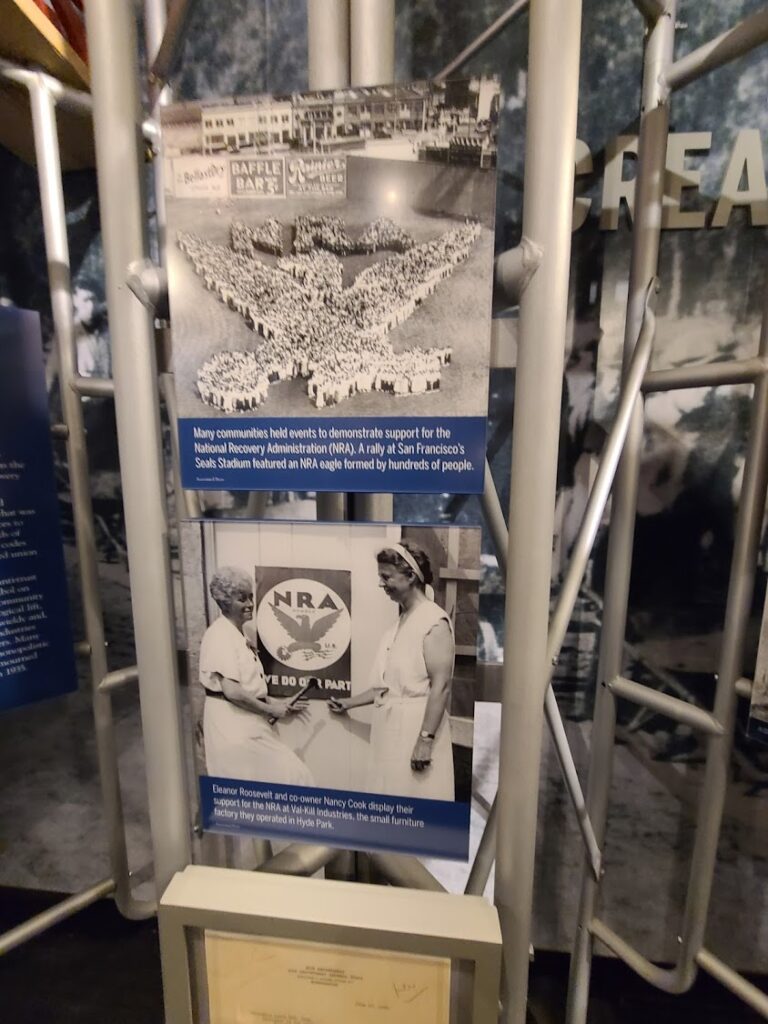
And the exhibit offered this description of Schechter Poultry:
. . . but the NRA proved ineffective. Its codes were unwieldy, and sometimes, ludicrous--including regulations for industries like shoulder pads, dog food, and burlesque theaters. Many codes favored larger businesses and encouraged monopolistic practices that hindered economic recovery. Few mourned when the NRA was declared unconstitutional in 1935.
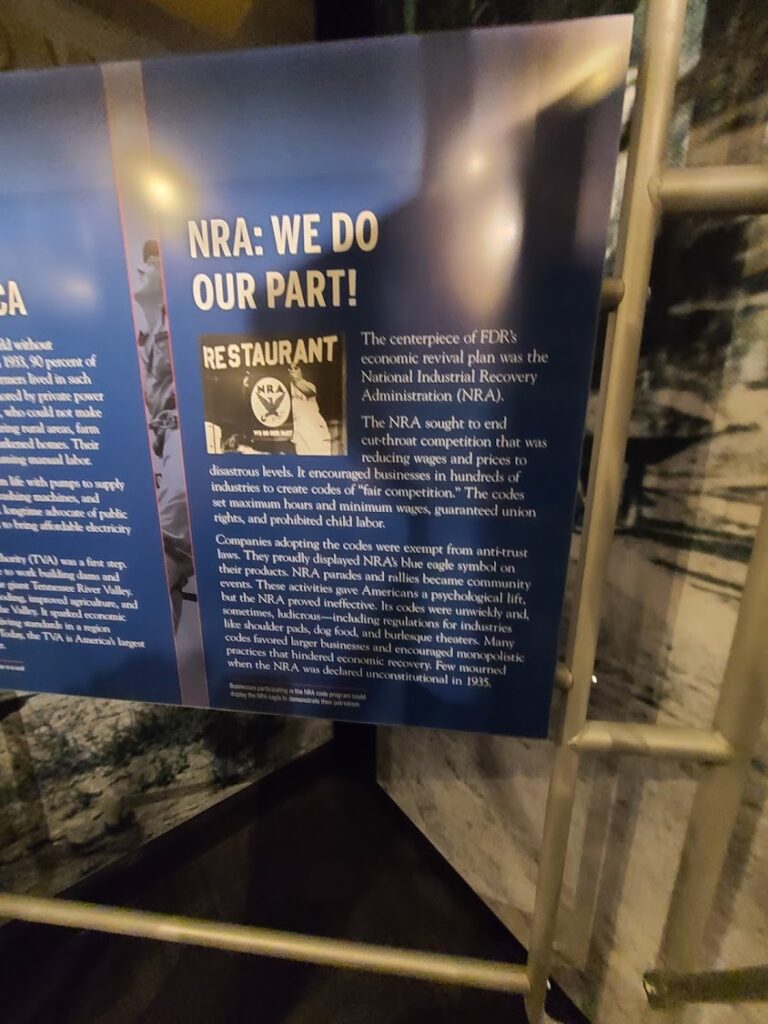
Fifth, there was an exhibit that discussed Court packing in FDR's second term.
But FDR's plan's soon went awry. Flushed with victory, the emboldened President overreached. A divisive battle with the Supreme Court and an unsuccessful effort to "purge" conservatives from the Democratic Party energized his opponents.
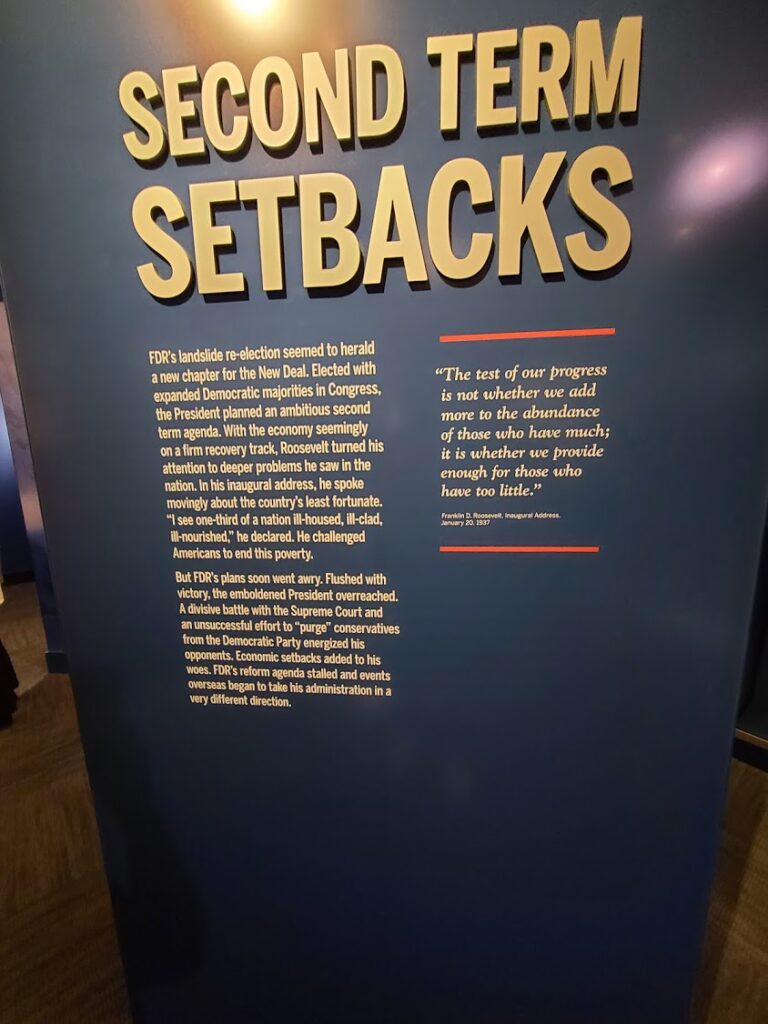
The next panel was titled "The Supreme Court fight."
During FDR's first term the Supreme Court became a major threat to the New Deal. A conservative 5-4 Court majority disapproved of Roosevelt's expansion of Federal power. In 1935-1936, these Justices began striking down key New Deal laws, including the NRA and AAA, as unconstitutional. FDR feared future rulings would overturn other reforms, including Social Security.
Mostly accurate. Schechter Poultry, which declared the NRA unconstitutional, was 9-0.
In 1937, Roosevelt moved to remake the Court. He requested legislation empowering him to add up to six new Justices for every current justice over age 70. Outraged critics charged he wanted to "pack" the Court. The Senate buried FDR's proposal in committee.
This passage underplays the extent to which members of the Democratic party opposed the plan. Both Houses of Congress had large majorities of Democrats.
The outcome of the Court fight was FDR's greatest legislative defeat. but it became apparent that while he lost the battle, he won the war. During 1937, one conservative justice switched allegiances and began supporting New Deal legislation.This switch--and later Court retirements--let FDR shape a pro-New Deal majority without radical change.
This passage buys into the "Switch in Time" narrative that has been fairly conclusively debunked. And Justice Roberts' so-called "switch" occurred in West Coast Hotel, which involved a state law, rather than a federal law.
And here's the kicker:
From 1937 until the 1990s the Court consistently supported a broad reading of Federal power in the economy.
This far, but no farther.
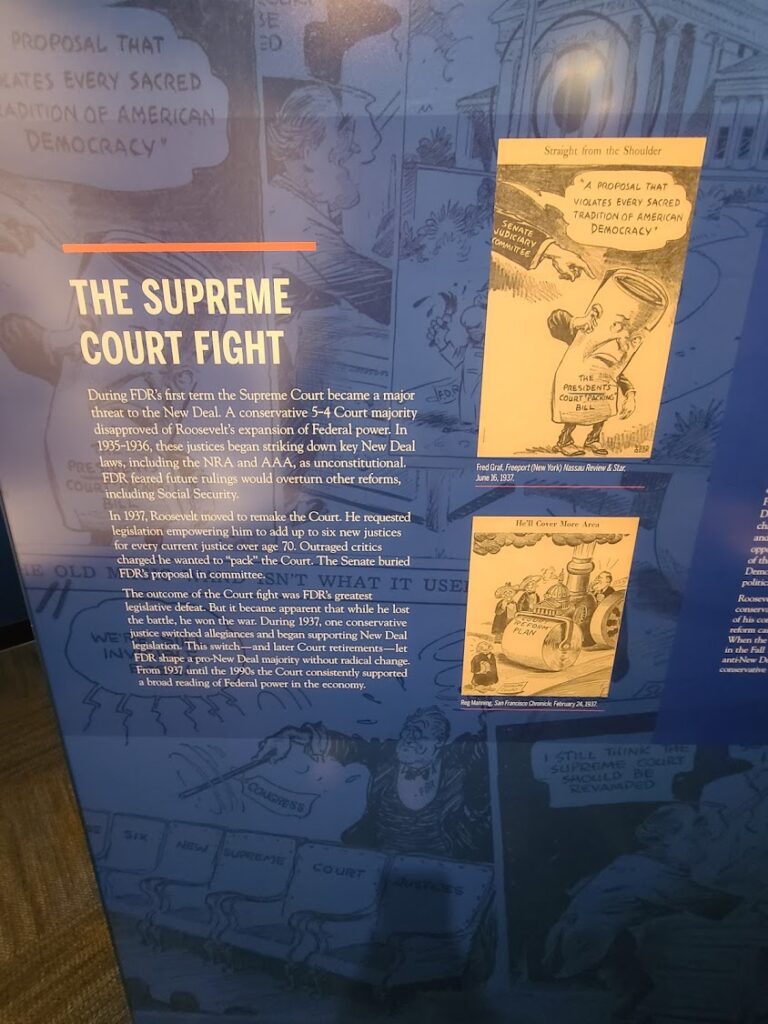
There are also two political cartoons. One depicts the Senate Judiciary Committee telling the President that his proposal "violates every sacred tradition of American democracy." Another cartoon depicts Roosevelt driving a steam roller, labelled "Court Reform Plan," ready to plow over a Supreme Court Justice.
Sixth, there is an extensive exhibit on Japanese internment. To the library's credit, the exhibit acknowledges that the threat of Japanese sabotage was never substantiated:
In the uncertain weeks after Pearl Harbor, many Americans--particularly those on the Pacific coast--feared enemy attacks and saw danger in every corner.
These fears, combined with racial prejudice, led to a great injustice. Early in 1942, civilian and military leaders on the West Coast charged that members of the region's large Japanese American community might be working with Japan's military to plan acts of sabotage. Though no serious evidence of this existed, they pushed the Roosevelt administration for action.
On February 19, 1942, FDR issued Executive Order 9066, which led to the forced relocation of approximately 120,000 Japanese Americans living on the West Coast. More than two-thirds of these people were native born American citizens. They were confined in inland internment camps operated by the military.
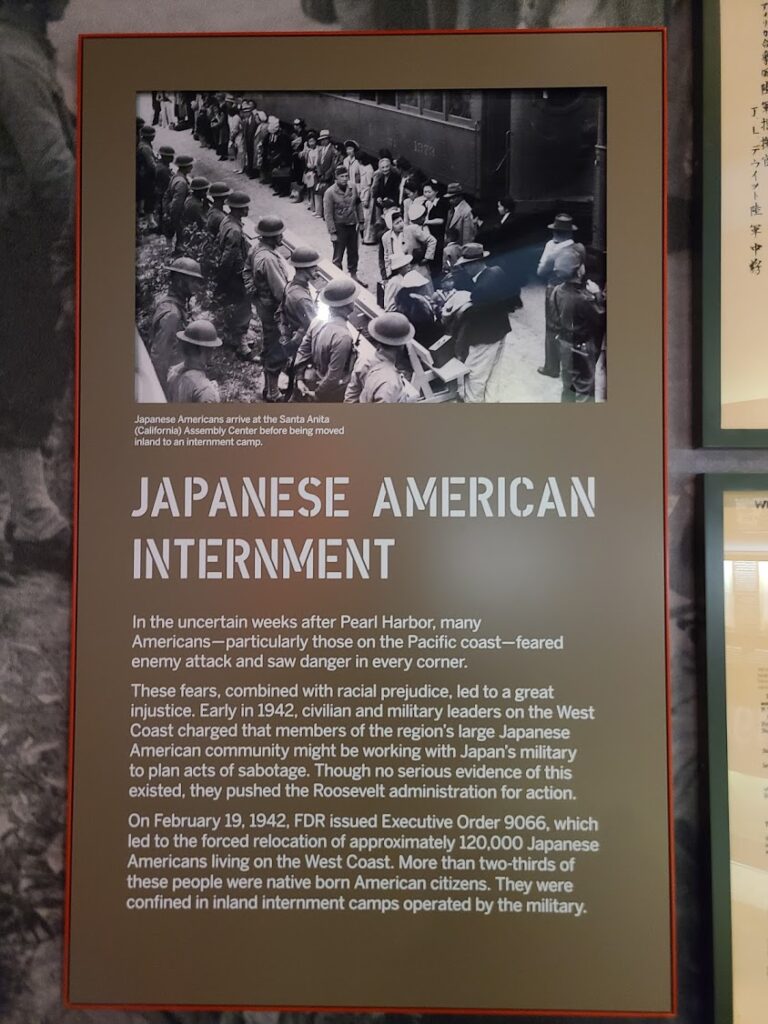
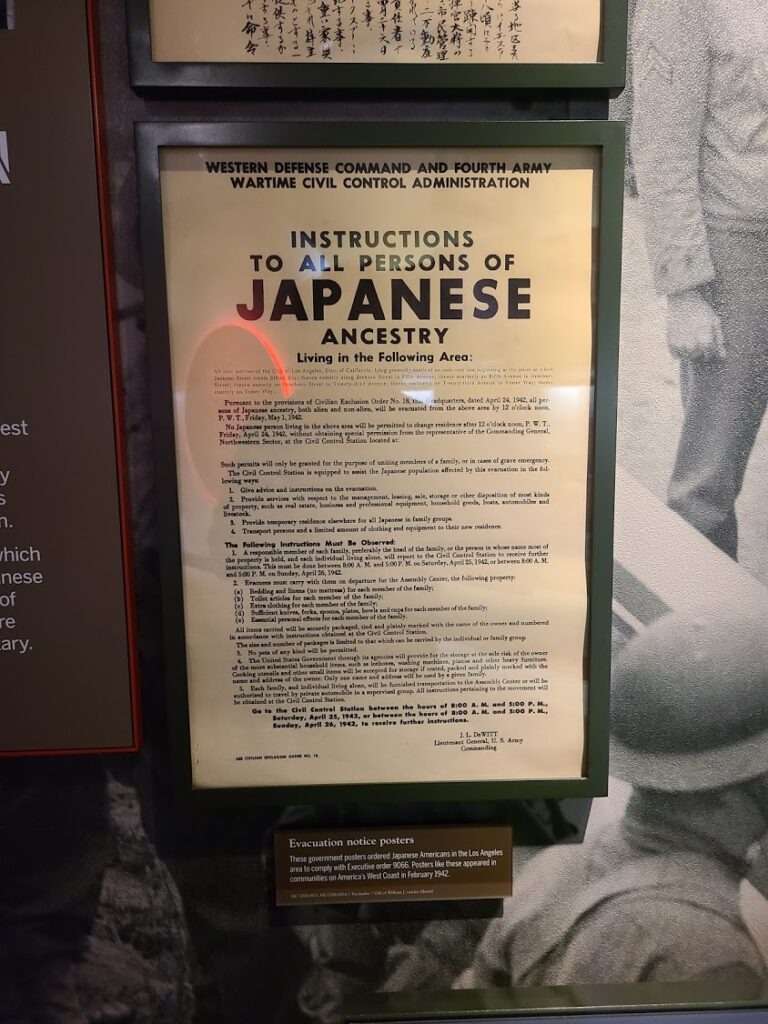
The exhibit also offered a somewhat candid account of Eleanor Roosevelt's position on internment.
Eleanor Roosevelt opposed internment and tried to stop FDR from issuing Executive Order 9066. Concerned about the potential hysteria against Japanese Americans, she visited Japanese American communities and praised their patriotism. But when she discussed the issue with FDR he was unmoved.
ER did not speak out publicly against her husband's decision, opting instead to work quietly behind the scenes. But many in the Japanese American community knew of her sympathies. In April 1943 she visited the Gila River relocation camp in Arizona. She was impressed by the character and perseverance of the detainees. In a report to FDR she urged him to relax the order and allow detainees to return to their homes. ER's report helped convince FDR to explore releasing some with work permits. By the end of 1943, one-third had been released from the camps. It would not be until January 1945, however, before the Executive order was rescinded and all the internees were released.
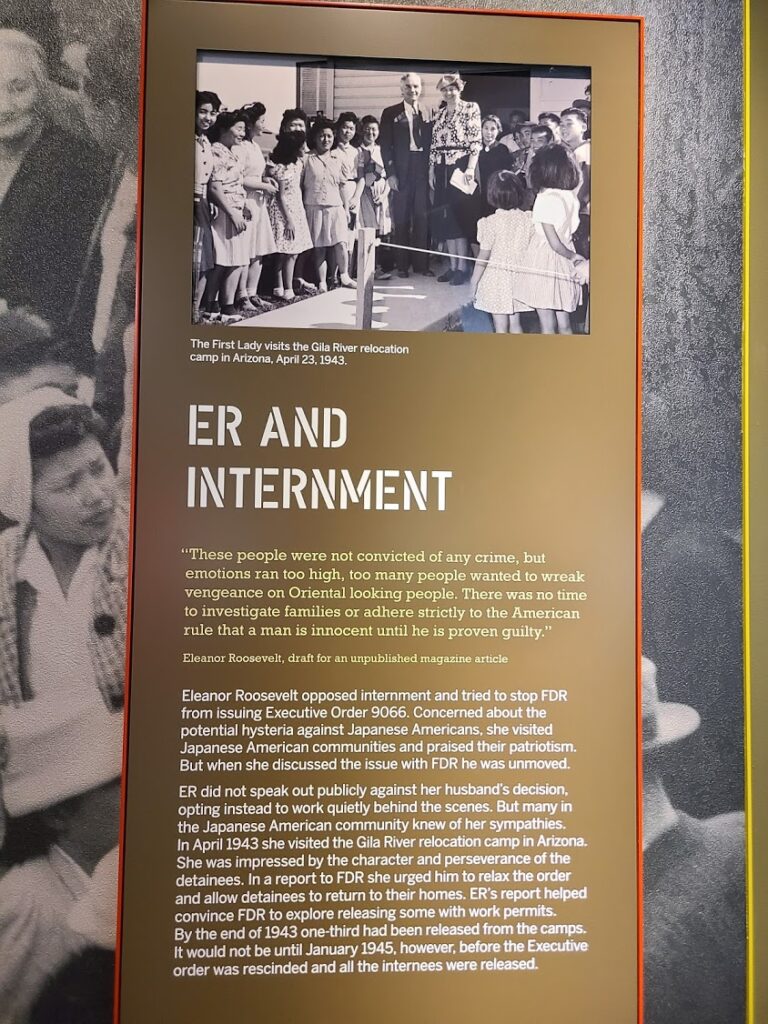
I discussed Eleanor Roosevelt's public defense of internment in a 2015 blog post.
As best as I can recall, the name Fred Korematsu appeared nowhere in the exhibit. There were opaque references to Korematsu and Hirabayashi as "two wartime cases," but nothing about Ex Parte Endo:
The Supreme Court upheld the President's Executive order in two wartime cases. But in the 1980s, the United States Congress acknowledged this gross violation of the civil liberties of American citizens and voted to provide some financial compensation to individuals confined in the camps. The Supreme Court also vacated its earlier wartime rulings.
This last sentence is perplexing. Is the exhibit referring to Trump v. Hawaii, which declared Korematsu overruled in the "Court of history"? I'm not entirely sure what is going on here.
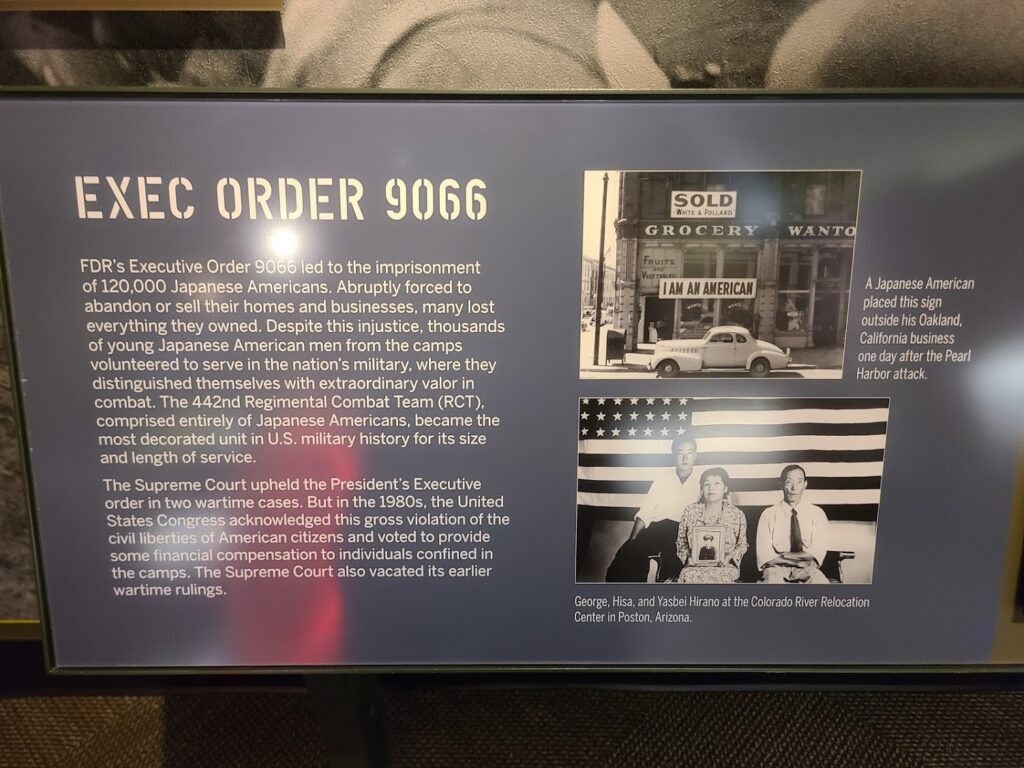
Finally, there is a picture of Chief Justice Harlan Fiske Stone administering the oath of office to President Truman.
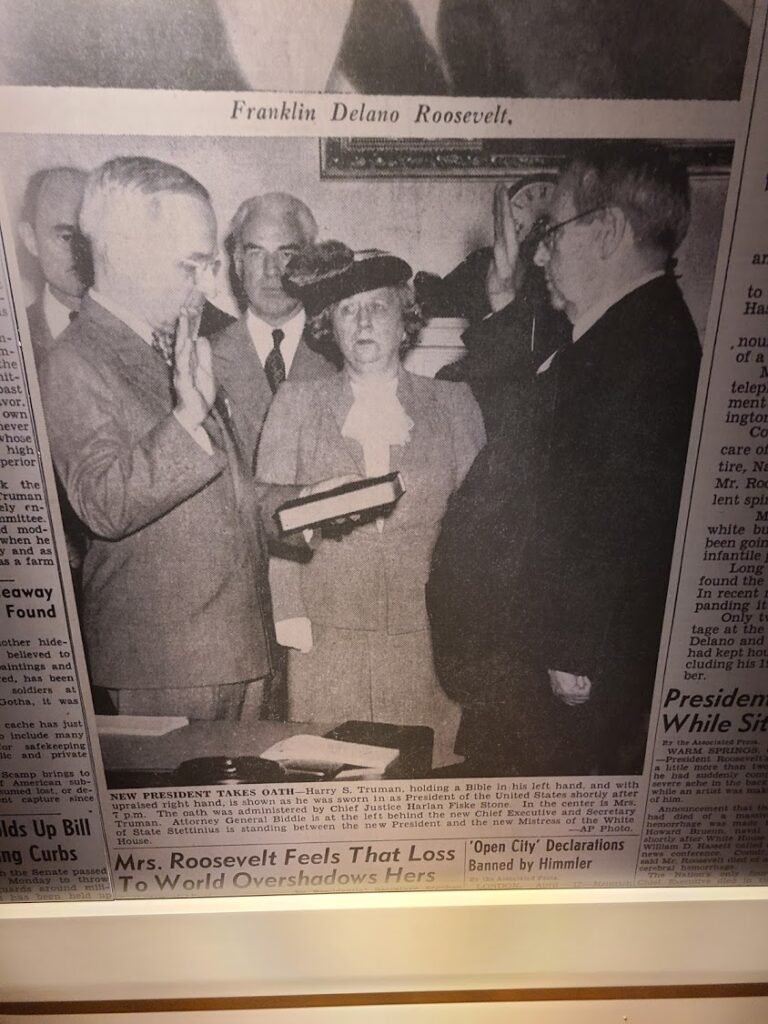
I hope others can visit the FDR library. I still need to visit five other presidential libaries: Nixon, Kennedy, Eisenhower, Truman, and Hoover.
Editor's Note: We invite comments and request that they be civil and on-topic. We do not moderate or assume any responsibility for comments, which are owned by the readers who post them. Comments do not represent the views of Reason.com or Reason Foundation. We reserve the right to delete any comment for any reason at any time. Comments may only be edited within 5 minutes of posting. Report abuses.
Please to post comments


Poster boy for the Ivy indoctrinated lawyer dumbass, an unmitigated catastrophe for our hapless nation. Plunged our nation into a deeper depression. Failed to prevent a self evidently coming war. Kowtowed to Stalin, and gave away half of Europe. A dunderhead. An idiot. Did they mention how many times he could not pass the NY Bar exam?
How about racist concentration camp Commandant of concentration camps, anti-Semite, dirty Commie, big government advocate, little tyrant, enabler of the Holocaust out of Jew hatred? Was that covered at that scumbag library? Owens wins 4 Gold Medals, did not get a dinner, at the White House. Mediocre white losers, they got a dinner.
The most overrated President in history.
Soviet stooge who gave away several openings for the future cold war
Socialistlite
Sparked the trend toward big government and intrusiveness
worsened the Great Depression
chipped away at private liberty for weak reasons(gold seizures, japanese internment)
contemptuous of republican safeguards (term limits, court packing)
The best you could say about him is he had the fortune of being President during wartime where he could sit back and not interfere too much with generals who could also sit back and let Hitler destroy himself just worrying about picking up more pieces than the Soviets after. What a hero
AmosArch
July.18.2021 at 7:58 pm
Flag Comment Mute User
The most overrated President in history.
Soviet stooge who gave away several openings for the future cold war"
An excellent book to read is Stalin's war by McKeeken. Between the lend lease program and the capitulation to every demand of stalin, Roosevelt probably did more to facilitate the cold war and the destruction of eastern europe than any other person with the exception of stalin
Better watch your hyperbole. These two things --
are in opposition. No Soviet stooge can be socialist-lite by any stretch of any imagination.
“I'm not entirely sure what is going on here.”
The museum’s curators—like everyone else—probably have a blind spot when their causes célèbres are involved.
During the Trump administration, I learned a lot, including about myself. I saw intelligent, educated, knowledgeable people lose their minds about Trump, despite his great achievements. Facts lost all influence. They were more insular and provincial than the dwellers of the deepest holler in Kentucky. I see my own views this way, as just biased feelings.
I saw the tech billionaire owned media select the coverage and the facts to promote an agenda. This agenda served their purpose of enrichment from kowtowing, and getting access to the Chinese Commie Party. I saw our tech billionaires as 10 times smarter and 1000 times more powerful than the rest of us. I saw the Chinese oligarchs who own the Chinese Commie Party as twice as smart and as successful as our tech billionaires.
The facts are out on display, yet only some will serve to influence policy making. 99% of people have no self awareness of this blindness. This anosagnosia is as deep as the stroke victim whose occipital lobes have been destroyed. He can no longer receive light sensations from his eyes, but insists there is nothing wrong with his vision.
( https://en.wikipedia.org/wiki/Cortical_blindness )
There is no treatment save for prolonged suffering an slow realization. It's a problem.
The best thing to do is to visit the Vanderbilt Mansion after the FDR library…the grandeur of the Vanderbilt Mansion overwhelms FDR’s house.
The Bush 43 Library is just a drab Orwellian propaganda organ…best to ignore it or go in knowing it’s the biggest pile of bullshit in Texas. I will visit the Clinton library next year in the early summer so I can catch a minor league baseball game when the weather is nice.
My mother (now age 90) would tell us of the nationwide mourning when FDR died. He had led the country through so much, and then he was gone. To young people he was the only President they could remember. I can imagine.
The Democrat dominated press did more than cover up his ailments, impairments, infidelities. They covered up the damage to the country.
" My mother (now age 90) would tell us of the nationwide mourning when FDR died. "
Your mainstream content has little or no place at this blog, particularly with respect to Prof. Blackman's commentary.
What bothered me most about the Japanese internment is that it was done with an executive order. No Congressional debate, no public debate. The declaration of war took longer! That tells me FDR and everybody involved knew it stank. And the Supreme Court didn't give a fig. Stroke of a pen, 100,000 people uprooted, all their homes and businesses sold for pennies. No legal objection.
There was a provoking incident, which may well have made FDR believe that a military emergency existed although I agree with you that he should have known better. The incident took place in the days immediately following Pearl Harbor, on the Hawaiian island of Niihau, and Military History magazine did an article about it, I don't recall how long ago.
And when a U-Boat landed actual German saboteurs on the East Coast, did that provoke German internment?
It doesn't wash the stink away to claim "provocation".
Provocation is just lawyer nitpicking in bad faith, as COVID was a provocation to shut down the economy and to steal the election from Trump. It is not a crime, but deserves an ass kicking. We are sick of you lawyers, the most toxic occupation in the country, 10 times more toxic than organized crime.
Not quite the same. The Niihau Incident involved people of Japanese descent who *already* lived in the US. 100% of them (admittedly, this was a grand total of three people) aided and abetted a member of the Japanese military who took part in the attack on Pearl Harbor, going as far as taking up arms to help him escape.
It's not a good justification for the Japanese internment, but it's not nothing, either. And it's definitely not the same as a German U-boat landing German military saboteurs.
Please note that I'm not saying that the internment was correct or a good thing.
The problem with claiming that the Ni'ihau incident "provoked" internment, besides the racism inherent in the claim, is that they didn't actually intern all those of Japanese ancestry in Hawai'i itself. If they had really been worried about security, that would've been the place to start — not thousands of miles away in a place that wasn't actually vulnerable to Japanese attack the way Hawai'i had been proven to be.
Thanks for sharing these pictures, it looks like a great museum.
Was there any mention of FDR's polio, or his frequent trips with a lady nurse to a spa at Warm Springs, GA to treat it? He was there with the nurse when he died. Depending on whom you ask there may have been more going on between the two of them.
Did FDR have ED? That would be interesting to find out at that garbage propaganda outlet.
Josh. Did the museum cover the Roosevelt bowel and bladder problems? I would visit for that discussion, plus the role of that "nurse" of his in helping him. For example, did he need an adult diaper? How often did she have to change it? Were any preserved for historical investigation?
We know he failed the Bar exam before being infected by polio. However, polio attacks neurons. Its effects on the spinal cord are well known. Did polio affect the Roosevelt brain at age 39? Was an autopsy done on the President? Is that report in the museum? Were brain slides preserved for forensic pathology review today? Could he have passed the abusive and nasty neurologic testing that Swamp subjected Trump to?
Is it known if he ever made a stinky during one of those sycophantic Democrat press conferences? What did the press think at the time?
Looks like a statue rip to be torn down come the revolution.... When the time comes all vestiges of communism and marxism are going to need to go.
There's a decent case that FDR's fireside chats saved capitalism in America.
It has been widely accepted that the New Deal was a disaster as far as economic relief and drug along the Great Depression for much longer than necessary to recover.
Trying to give cover to your fellow marxist isn't going to fly here, nor will it in the future.
You changed the subject. Do you think FDR did his fireside chats because he wanted to kill capitalism himself?
As to 'it's been widely accepted...' Nice passive voice. It has not been widely accepted, except among a small subset of academics, who need that to be true or else their thesis is blown up.
In reality, most everyone acknowledges the New Deal was successful, and we're all Keynsians now.
Having been to half a dozen presidential libraries myself - same list but substitute Nixon and Lincoln for Clinton and Ford - it’s interesting to me that Democrat libraries usually present their subjects as saints who never sinned, while Republican libraries present a warts-and-all image. Now that I know the FDR library breaks this mold, I’m more likely to make the trip.
I did note that all the critical sections had a "Yeah, but..." somewhere in there. For example:
"Early in 1942, civilian and military leaders on the West Coast charged that members of the region's large Japanese American community might be working with Japan's military to plan acts of sabotage. Though no serious evidence of this existed, they pushed the Roosevelt administration for action."
That's a really weak 'yeah, but.'
Two observations:
The sculptures are poor likenesses, and poor sculpture.
And where was Eleanor when her husband was taking the oath of his Presidency? Mrs. Truman damn sure made herself conspicuous at her husband's oath.
Addendum: Behar is a malignant wack.
Thanks to the prodigious publishing professor from Texas for the interesting post about the Roosevelts.
In an era of toppling statues, I am not sure how this and other FDR statues survive. Putting a couple of hundred thousand citizens into concentration camps, including small children, because of their race seems like it would make FDR rise to the top of the list of those whose statues have to come down. Maybe there is some other criteria?
Any word as to when you will visit the Trump Presidential Library? That will be a real treat.